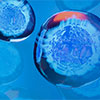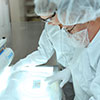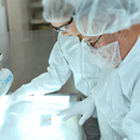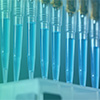PendoTech®+Single-Use+Sensors
Artikel-Nr:
(BOSSBS-12859R-A555)
Lieferant:
Bioss
Hersteller-Artikelnummer::
BS-12859R-A555
Lokale Artikelnummer::
BOSSBS-12859R-A555
Beschreibung:
Crystallins are the major proteins of the vertebrate eye lens, where they maintain the transparency and refractive index of the lens. Crystallins are divided into a, b, and g families, and the b- and g-crystallins also comprise a superfamily. Crystallins usually contain seven distinctive protein regions, including four homologous motifs, a connecting peptide, and N- and C-terminal extensions. b-crystallins constitute the major lens structural proteins. They associate into dimers, tetramers, and higher order aggregates. The b-crystallin subfamily is composed of several gene products, including bA1-, bA2-, bA3-, bA4-, bB1-, bB2- and bB3-crystallin. The bA1- and bA3-crystallin proteins are encoded by a single mRNA. They differ by only 17 amino acids, and bA1-crystallin is generated by use of an alternate translation initiation site. The genes for bA4-, bB1-, bB2- and bB3-crystallin are clustered on human chromosome 22q11, while the genes for bA3/A1- and bA2-crystallin map to human chromosomes 17q11 and 2q34, respectively.
VE:
1 * 100 µl
Artikel-Nr:
(BOSSBS-12859R-A488)
Lieferant:
Bioss
Hersteller-Artikelnummer::
BS-12859R-A488
Lokale Artikelnummer::
BOSSBS-12859R-A488
Beschreibung:
Crystallins are the major proteins of the vertebrate eye lens, where they maintain the transparency and refractive index of the lens. Crystallins are divided into a, b, and g families, and the b- and g-crystallins also comprise a superfamily. Crystallins usually contain seven distinctive protein regions, including four homologous motifs, a connecting peptide, and N- and C-terminal extensions. b-crystallins constitute the major lens structural proteins. They associate into dimers, tetramers, and higher order aggregates. The b-crystallin subfamily is composed of several gene products, including bA1-, bA2-, bA3-, bA4-, bB1-, bB2- and bB3-crystallin. The bA1- and bA3-crystallin proteins are encoded by a single mRNA. They differ by only 17 amino acids, and bA1-crystallin is generated by use of an alternate translation initiation site. The genes for bA4-, bB1-, bB2- and bB3-crystallin are clustered on human chromosome 22q11, while the genes for bA3/A1- and bA2-crystallin map to human chromosomes 17q11 and 2q34, respectively.
VE:
1 * 100 µl
Artikel-Nr:
(BOSSBS-11957R-A680)
Lieferant:
Bioss
Hersteller-Artikelnummer::
BS-11957R-A680
Lokale Artikelnummer::
BOSSBS-11957R-A680
Beschreibung:
SLITRK family proteins are integral membrane proteins that have a C-terminal domain that is partially similar to TRK neurotrophin receptor proteins and two leucine-rich repeat (LRR) domains that are similar to those of SLIT proteins. SLITRK4 (SLIT and NTRK-like protein 4) is a 837 amino acid single-pass type I membrane protein that contains 18 LRR (leucine-rich) repeats and is expressed in neural tissues, specifically in the thalamus, hypothalamus, subventricular zone, CA3 region of the hippocampus and cortical plate. SLITRK4 may be upregulated in some astrocytic brain tumours such as glioblastomas, astrocytomas and primitive neuroectodermal tumours. As compared with its family member SLITRK2, SLITRK4 only weakly suppresses neurite outgrowth. A study using genome-wide transcriptional profiling suggested that the gene encoding SLITRK4, as well as the ARL5B and PLA2G7 genes, may be involved in the pathogenesis of preeclampsia.
VE:
1 * 100 µl
Artikel-Nr:
(BOSSBS-11153R-CY5)
Lieferant:
Bioss
Hersteller-Artikelnummer::
BS-11153R-CY5
Lokale Artikelnummer::
BOSSBS-11153R-CY5
Beschreibung:
Protocadherins are a large family of cadherin-like cell adhesion proteins that are involved in the establishment and maintenance of neuronal connections in the brain. There are three protocadherin gene clusters, designated alpha, beta and gamma, all of which contain multiple tandemly arranged genes. PCDHB12 (Protocadherin beta 12) is a 795 amino acid protein that is one of 16 proteins in the protocadherin beta cluster. Unlike the alpha and gamma gene clusters whose genes are spliced to downstream constant region exons during transcription, members of the beta cluster (such as PCDHB12) do not use constant-region exons to produce mRNAs. As a result, each protocadherin beta gene encodes the transmembrane, extracellular and short cytoplasmic domains of the protein. Localized to the cell membrane, PCDHB12 is a single-pass type I membrane protein that contains six cadherin domains. PCDHB12 may participate in the establishment and maintenance of specific neuronal connections in the brain.
VE:
1 * 100 µl
Artikel-Nr:
(BOSSBS-11957R-A350)
Lieferant:
Bioss
Hersteller-Artikelnummer::
BS-11957R-A350
Lokale Artikelnummer::
BOSSBS-11957R-A350
Beschreibung:
SLITRK family proteins are integral membrane proteins that have a C-terminal domain that is partially similar to TRK neurotrophin receptor proteins and two leucine-rich repeat (LRR) domains that are similar to those of SLIT proteins. SLITRK4 (SLIT and NTRK-like protein 4) is a 837 amino acid single-pass type I membrane protein that contains 18 LRR (leucine-rich) repeats and is expressed in neural tissues, specifically in the thalamus, hypothalamus, subventricular zone, CA3 region of the hippocampus and cortical plate. SLITRK4 may be upregulated in some astrocytic brain tumors such as glioblastomas, astrocytomas and primitive neuroectodermal tumors. As compared with its family member SLITRK2, SLITRK4 only weakly suppresses neurite outgrowth. A study using genome-wide transcriptional profiling suggested that the gene encoding SLITRK4, as well as the ARL5B and PLA2G7 genes, may be involved in the pathogenesis of preeclampsia.
VE:
1 * 100 µl
Artikel-Nr:
(BOSSBS-11153R-A750)
Lieferant:
Bioss
Hersteller-Artikelnummer::
BS-11153R-A750
Lokale Artikelnummer::
BOSSBS-11153R-A750
Beschreibung:
Protocadherins are a large family of cadherin-like cell adhesion proteins that are involved in the establishment and maintenance of neuronal connections in the brain. There are three protocadherin gene clusters, designated alpha, beta and gamma, all of which contain multiple tandemly arranged genes. PCDHB12 (Protocadherin beta 12) is a 795 amino acid protein that is one of 16 proteins in the protocadherin beta cluster. Unlike the alpha and gamma gene clusters whose genes are spliced to downstream constant region exons during transcription, members of the beta cluster (such as PCDHB12) do not use constant-region exons to produce mRNAs. As a result, each protocadherin beta gene encodes the transmembrane, extracellular and short cytoplasmic domains of the protein. localised to the cell membrane, PCDHB12 is a single-pass type I membrane protein that contains six cadherin domains. PCDHB12 may participate in the establishment and maintenance of specific neuronal connections in the brain.
VE:
1 * 100 µl
Artikel-Nr:
(BOSSBS-11153R-A680)
Lieferant:
Bioss
Hersteller-Artikelnummer::
BS-11153R-A680
Lokale Artikelnummer::
BOSSBS-11153R-A680
Beschreibung:
Protocadherins are a large family of cadherin-like cell adhesion proteins that are involved in the establishment and maintenance of neuronal connections in the brain. There are three protocadherin gene clusters, designated alpha, beta and gamma, all of which contain multiple tandemly arranged genes. PCDHB12 (Protocadherin beta 12) is a 795 amino acid protein that is one of 16 proteins in the protocadherin beta cluster. Unlike the alpha and gamma gene clusters whose genes are spliced to downstream constant region exons during transcription, members of the beta cluster (such as PCDHB12) do not use constant-region exons to produce mRNAs. As a result, each protocadherin beta gene encodes the transmembrane, extracellular and short cytoplasmic domains of the protein. localised to the cell membrane, PCDHB12 is a single-pass type I membrane protein that contains six cadherin domains. PCDHB12 may participate in the establishment and maintenance of specific neuronal connections in the brain.
VE:
1 * 100 µl
Lieferant:
VWR Collection
Beschreibung:
Diese Zellsiebe sind aus einem robusten Nylonnetz mit Poren in gleichmäßigem Abstand hergestellt und sind sterile, leicht zu bedienende Vorrichtungen zur schnellen Isolierung von Primärzellen für eine konsistente, einheitliche Einzelzellsuspension aus Gewebe. Entwickelt für den Schutz wertvoller Durchflusszytometrie- und Zellsortiergeräte durch das zuverlässige Entfernen von Klumpen und Partikeln von Zellsuspensionen und klinischen Proben vor der Analyse.
Lieferant:
Biotium
Beschreibung:
Reacts with viral glycoprotein of rabies virus strains SAD-Vnukovo and Pitman-Moore. This MAb is useful in detecting rabies virus by ELISA and Western. It is capable of neutralizing rabies virus. Rabies virus (Neurotropic virus) is a member of the Rhabdoviridae family. Rabies is a single stranded, neurotropic, negative sense RNA virus which encodes 5 proteins: a glycoprotein, a nucleoprotein, and three others. The mature virus has a bullet shape, a protein coat, and a lipid envelope. The outer surface of the virus is covered with thumb like glycoprotein projections 5-10 nm long and 3 nm in diameter. The virus averages approximately 780 nm in length. Lipid solvents destroy virus infectivity. Rabies virus is a very successful virus, with a very wide range of hosts. It causes an acute, central nervous system infection, characterized by CNS irritation, followed by paralysis and death. Approximately 50,000 human deaths each year are caused by rabies.
Artikel-Nr:
(BOSSBS-7651R-A488)
Lieferant:
Bioss
Hersteller-Artikelnummer::
BS-7651R-A488
Lokale Artikelnummer::
BOSSBS-7651R-A488
Beschreibung:
Deoxyribonuclease I gene is approximately 3.2 kb long with 9 exons separated by 8 introns. In the form of a bovine pancreatic enzyme preparation, it occupies an important place in the history of protein chemistry and enzymology: it was the first enzyme to be recognized as specific for DNA; it was the first DNase to be crystallized; and it was the first DNase for which a specific protein inhibitor was characterized. DNase I is a Ca2+ and Mg2+ dependant endonuclease. DNase I is synthesized in the pancreas and stored in zymogen granules. It has been used to reduce the viscosity of cystic fibrosis sputum. A DNase I-like enzyme appears to catalyze the degradation of chromatin to oligo- and mononucleosomes during apoptosis. A recent study has demonstrated an endonuclease with activity and antigenicity indistinguishable from DNase I in thymocytes, cells susceptible to apoptosis. DNase I is an endonuclease that hydrolyzes double-stranded or single stranded DNA preferentially at sites adjacent to pyrimidine nucleotides. The product of hydrolysis is a complex mixture of 5'-phosphate mononucleotides and oligonucleotides. In the presence of Mg ion, DNase I attacks each strand of DNA independently and the cleavage sites are random.
VE:
1 * 100 µl
Artikel-Nr:
(BOSSBS-9201R-CY5)
Lieferant:
Bioss
Hersteller-Artikelnummer::
BS-9201R-CY5
Lokale Artikelnummer::
BOSSBS-9201R-CY5
Beschreibung:
IGSF11 is also known as BTIGSF (brain and testis-specific immunoglobulin superfamily protein) or VSIG3 (V-set and immunoglobulin domain-containing protein 3) and is a 431 amino acid protein that is expressed as three isoforms. IGSF11 is highly expressed in testis and ovary and is also expressed in brain, kidney and skeletal muscle, localized to the cellular membrane as a single-pass membrane protein. IGSF11 is an immunoglobulin with V-type and C2-type domains that function in molecular recognition. When IGSF11 is in the trans position, it plays an important role in cell-cell adhesion via both homophilic and heterophilic interactions with other molecules. These cell–cell interactions are also thought to be important for neuronal cell interactions, such as neuron–neuron or neuron–glia interactions, which are important for the development and function of the central nervous system. In addition, IGSF11 might also be involved interactions between Sertoli cells and spermatocytes, which are important associations during spermatogenesis. The IGSF11 gene is commonly upregulated in gastric cancer and IGSF11 is highly expressed in many types of human tumors, indicating that it may be useful as a target for immunotherapy.
VE:
1 * 100 µl
Artikel-Nr:
(BOSSBS-9201R-A488)
Lieferant:
Bioss
Hersteller-Artikelnummer::
BS-9201R-A488
Lokale Artikelnummer::
BOSSBS-9201R-A488
Beschreibung:
IGSF11 is also known as BTIGSF (brain and testis-specific immunoglobulin superfamily protein) or VSIG3 (V-set and immunoglobulin domain-containing protein 3) and is a 431 amino acid protein that is expressed as three isoforms. IGSF11 is highly expressed in testis and ovary and is also expressed in brain, kidney and skeletal muscle, localized to the cellular membrane as a single-pass membrane protein. IGSF11 is an immunoglobulin with V-type and C2-type domains that function in molecular recognition. When IGSF11 is in the trans position, it plays an important role in cell-cell adhesion via both homophilic and heterophilic interactions with other molecules. These cell–cell interactions are also thought to be important for neuronal cell interactions, such as neuron–neuron or neuron–glia interactions, which are important for the development and function of the central nervous system. In addition, IGSF11 might also be involved interactions between Sertoli cells and spermatocytes, which are important associations during spermatogenesis. The IGSF11 gene is commonly upregulated in gastric cancer and IGSF11 is highly expressed in many types of human tumors, indicating that it may be useful as a target for immunotherapy.
VE:
1 * 100 µl
Artikel-Nr:
(BOSSBS-9201R-A555)
Lieferant:
Bioss
Hersteller-Artikelnummer::
BS-9201R-A555
Lokale Artikelnummer::
BOSSBS-9201R-A555
Beschreibung:
IGSF11 is also known as BTIGSF (brain and testis-specific immunoglobulin superfamily protein) or VSIG3 (V-set and immunoglobulin domain-containing protein 3) and is a 431 amino acid protein that is expressed as three isoforms. IGSF11 is highly expressed in testis and ovary and is also expressed in brain, kidney and skeletal muscle, localized to the cellular membrane as a single-pass membrane protein. IGSF11 is an immunoglobulin with V-type and C2-type domains that function in molecular recognition. When IGSF11 is in the trans position, it plays an important role in cell-cell adhesion via both homophilic and heterophilic interactions with other molecules. These cell–cell interactions are also thought to be important for neuronal cell interactions, such as neuron–neuron or neuron–glia interactions, which are important for the development and function of the central nervous system. In addition, IGSF11 might also be involved interactions between Sertoli cells and spermatocytes, which are important associations during spermatogenesis. The IGSF11 gene is commonly upregulated in gastric cancer and IGSF11 is highly expressed in many types of human tumors, indicating that it may be useful as a target for immunotherapy.
VE:
1 * 100 µl
Lieferant:
Biotium
Beschreibung:
Reacts with viral glycoprotein of rabies virus strains SAD-Vnukovo and Pitman-Moore. This MAb is useful in detecting rabies virus by ELISA and Western. It is capable of neutralizing rabies virus. Rabies virus (Neurotropic virus) is a member of the Rhabdoviridae family. Rabies is a single stranded, neurotropic, negative sense RNA virus which encodes 5 proteins: a glycoprotein, a nucleoprotein, and three others. The mature virus has a bullet shape, a protein coat, and a lipid envelope. The outer surface of the virus is covered with thumb like glycoprotein projections 5-10 nm long and 3 nm in diameter. The virus averages approximately 780 nm in length. Lipid solvents destroy virus infectivity. Rabies virus is a very successful virus, with a very wide range of hosts. It causes an acute, central nervous system infection, characterized by CNS irritation, followed by paralysis and death. Approximately 50,000 human deaths each year are caused by rabies.
Lieferant:
Biotium
Beschreibung:
Reacts with viral glycoprotein of rabies virus strains SAD-Vnukovo and Pitman-Moore. This MAb is useful in detecting rabies virus by ELISA and Western. It is capable of neutralizing rabies virus. Rabies virus (Neurotropic virus) is a member of the Rhabdoviridae family. Rabies is a single stranded, neurotropic, negative sense RNA virus which encodes 5 proteins: a glycoprotein, a nucleoprotein, and three others. The mature virus has a bullet shape, a protein coat, and a lipid envelope. The outer surface of the virus is covered with thumb like glycoprotein projections 5-10 nm long and 3 nm in diameter. The virus averages approximately 780 nm in length. Lipid solvents destroy virus infectivity. Rabies virus is a very successful virus, with a very wide range of hosts. It causes an acute, central nervous system infection, characterized by CNS irritation, followed by paralysis and death. Approximately 50,000 human deaths each year are caused by rabies.
Lieferant:
Mettler - Toledo
Beschreibung:
Mit diesem Einkanal-Messgerät können die komplexesten Anwendungen leicht bearbeitet und strenge Anforderungen in regulierten Märkten erfüllt werden. Das Messgerät ist flexibel und kann jederzeit mit zusätzlichen Messparametern modular erweitert werden. Spezielle Methoden für die gängigsten inkrementellen Ionen-Messtechniken sind im Lieferumfang enthalten, wie z. B. Methoden zur Standardaddition/-subtraktion und Probenaddition/-subtraktion.
Preis auf Anfrage
Lager für diesen Artikel ist begrenzt, kann aber in einem Lagerhaus in Ihrer Nähe zur Verfügung. Bitte stellen Sie sicher, dass Sie in sind angemeldet auf dieser Seite, so dass verfügbare Bestand angezeigt werden können. Wenn das
Lager für diesen Artikel ist begrenzt, kann aber in einem Lagerhaus in Ihrer Nähe zur Verfügung. Bitte stellen Sie sicher, dass Sie in sind angemeldet auf dieser Seite, so dass verfügbare Bestand angezeigt werden können. Wenn das
Dieses Produkt kann nur an eine Lieferadresse versandt werden die über die entsprechende Lizenzen verfügt. Für weitere Hilfe bitte kontaktieren Sie Ihr VWR Vertriebszentrum.
-Additional Documentation May be needed to purchase this item. A VWR representative will contact you if needed.
Dieses Produkt wurde von Ihrer Organisation gesperrt. Bitte kontaktieren Sie Ihren Einkauf für weitere Informationen.
Dieses Produkt ist Ersatz für den von Ihnen gewünschten Artikel.
Dieses Produkt ist nicht mehr verfügbar. Bitte kontaktieren Sie den VWR Kundenservice.
|
|||||||||

















































